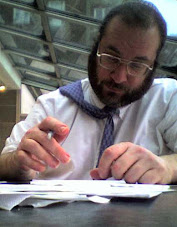Well, it's been about a month now since I
stretched my bicycle, but only last night did I finally reinstall the rear brakes, which pretty much completes the transformation of my plain old bicycle into a
SUB (see pic below for an example of what an
stretched bicycle looks like, and, more significantly, how much stuff it might be able to carry).
Tonight I not only did the
radical be-kind-to-the-earth-while-being-kind-to-yourself thing of going grocery shopping via bicycle (which I've actually been doing for some years now, even during my years in the
internal combustion kingdom of Los Angeles), but I actually used a
paper grocery bag at the self-checkout line (something I had never witnessed before in these parts -- a locale where the checkout people most definitely do _not_ say "paper or plastic?" before plunging your groceries into some solidified petrochemicals).
Soon after I placed the paper bag (which I should add was provided by the supermarket itself right there next to my self-checkout station), the young woman in charge of the area came plodding by. She silently looked me over with palpable suspicion and peered into the bag to make sure I hadn't sneaked anything in there before having the temerity to break the normal
plastic routine. . . . Apparently, using a paper bag must be on the official shoplifter profile they train these self-checkout overseers with. I'm happy to say that me and my groceries were allowed to leave the store without incident!
Before going to the supermarket, I took my SUB (well, actually, I'd rather just call it an
Xtracycle) on the longest ride I've gone on with it, yet, about 30 kilometers (about 18 miles), including a climb up one of the steeper hills around here (with about a 600 foot climb) -- a pretty good Sunday afternoon workout for the likes of me. :) . . . The bike did fine, and soon I may build up the confidence to take it on longer trips.
The paper bag thing, by the way, was not just about upsetting the supermarket personnel. I realized the other night that the Xtracycle is pretty much incompatible with the common plastic grocery bag: Note, in the picture above, that the sides of the bags on the Xtracycle really don't come up very high. So, if you really want to get your money's worth out of this thing (cargo carrying wise), then you have to put your stuff into something (like a box or a paper grocery bag) that has a little structural integrity of its own and can hold some stuff
higher than the side of the Xtracycle bags.

But, in fact, I have no intention of
converting to paper bags. Maybe I would if they were the nice, strong ones that the likes of
Trader Joe's has with the handles, but the ones in the supermarkets here (if you can find them!) are not such premium-quality grocery holders. So, I ordered four
ACME bags (see, image on the left) from
http://www.reusablebags.com. They're supposed to be exactly the same size as paper grocery bags and they're supposed to stand up on their own like paper bags. I think the Xtracycle should be able to easily accommodate four of these completely loaded plus additional stuff on top of the
snap deck that sits above the rear wheel, between the bags.
Below, by the way, is a pic of an Xtracycle with two
Trader Joe's style grocery bags on each side. Note, by the way, that this bike looks very different from the one in the pic above. That's because the Xtracycle is a conversion kit that can be added to just about any bicycle. In essence, it lengthens the bike frame to accommodate super big bags to carry lots of cargo. For me, it's part of my pursuit of a long-time dream: a lifestyle -- one that will be kinder to both me and the earth -- that does not have the internal combustion engine at its center. It's also part of my love of things that are simple and versatile. People who know my cooking, for example, know that I eschew gadgets (no garlic presses or yogurt machines please!) in favor of a nice sharp chef's knife, a big cutting board and a big cast iron pan (almost anything worth doing can be done with little more than those few things). The bicycle is one such wonderfully simple and versatile machine. But we Americans too often tend to impose our need for complexity and specialization upon it -- routinely marketing bikes that are meant only to be a
toy, for recreation or exercise (have you noticed how many bicycles have no
braze-on's for a rack to be easily attached? . . . scandalous!). The Xtracycle is a machine that
is indeed a wonderful toy. But this toy is also a workhorse. Simplicity
and versatility. . . . Now with (rear) brakes, too. :)

P.S. For a wonderful explication of just how much cooking can be done with just a little equipment, see
this article from the New York Times' "The Minimalist."



